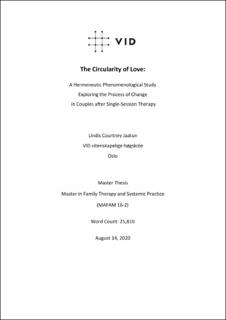| dc.description.abstract | In this study, I wanted to shed light on how couples experience change as a result of attending single-session therapy (SST). The research question in this study is: “How does the couple experience the process of change within the first week after attending an SST focused on defining the problem?” To answer this question, I have conducted a qualitative interview with four couples who have undergone this single session. Using a version of interpretative phenomenological analysis (IPA), I came up with 4 key findings:
1. The informants experienced improved communication
2. The informants experienced a cognitive shift in the way they viewed themself and their partner
3. The informants experienced a positive circular effect of kind acts
4. The informants experienced increased relational trust
I have discussed the empirical material in light of previous research on the process of change and SST. The theories that support this study include: systemic couple therapy, the well-adjusted couple relationship, the integrated model of systemic formulation and intervention as well the theory of what works in therapy. Three out of the four couple informants reported positive changes in their relationship in the week following the SST. The therapist’s ability to get them to openly talk about couple problems in therapy facilitated cognitive, behavioral and emotional changes that continued throughout the week. The positive outcome was related to the therapist conducting the session in accordance with the extensive research on what works in therapy, as well as the three decades of research on how to facilitate an effective SST. These three couples who achieved the most positive outcomes displayed characteristics of a well-adjusted relationship in which both parties were invested in meeting their partner’s needs while getting their own needs met. The fourth couple that experienced no significant positive outcome was resistant to change and the therapist was unable to execute an effective session. Furthermore, this case discrepancy couple did not appear to be equally invested in fulfilling their partner’s needs. The significance of the differentiation in outcomes can have clinical implications for which couples are best suited for SST and what types of therapeutic interpersonal relationship styles and strategies are necessary to deliver a transformative session with resistant clients. | en_US |
